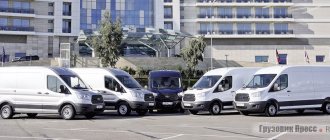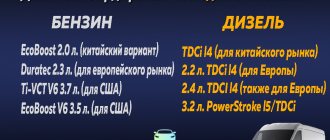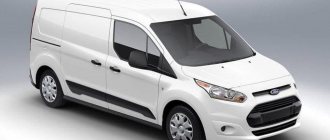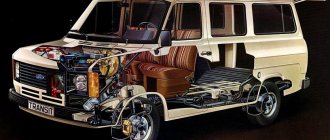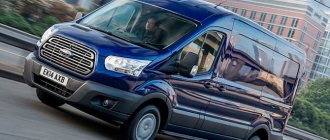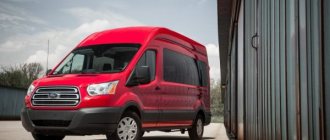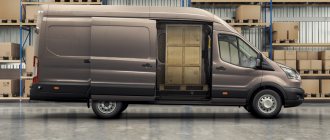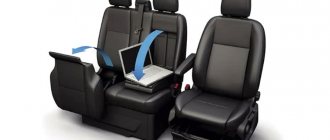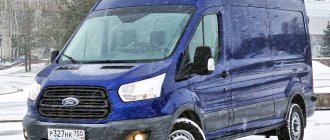Specifications
Modifications:- Van - cargo van
- Jumbo Van - van with increased load capacity/volume
- Kombi - cargo-passenger station wagon
- Bus M1 - 9-seater bus
- Bus M2 - 14-seater bus
- Bus 17 seat - 17-seater bus
Wheelbases:
SWB - short wheelbase (2933 mm) - compact, maneuverable modifications are ideal on city routes, without compromising on load capacity and capacity. MWB - medium wheelbase (3300 mm) - allows you to transport cargo of impressive lengths LWB - long wheelbase (3750 mm) - the arrangement allows for the transportation of almost any non-standard cargo.
Drive unit:
RWD/V184 - rear-wheel drive modification - is ideal in cases where increased load capacity is required, since it ensures stability and controllability even in the most loaded state. The new rear axle design with semi-weighted axles provides additional fuel savings.
FWD/V185 - front-wheel drive modification - having slightly reduced the maximum load capacity due to the front-wheel drive layout, the car acquired phenomenal maneuverability and controllability. In addition, the level of the cargo area has become lower, which greatly facilitates unloading and loading.
Roof height (height from floor to roof):
- LR - low (RWD 1330mm/FWD 1460mm)
- MR - medium (RWD 1645mm/FWD 1745mm)
- HR - high (RWD 1885mm/FWD 1985mm)
Modifications of Ford Transit V347/348:
| 1 | 2.8(280) |
| 1.3 | 3.0(300) |
| 1.5 | 3.3(330) |
| 1.7 | 3.5(350) |
| 1.9 | 4.2(425) |
Engines
— New 16-valve DuraTorq diesel engines
Front-wheel drive - engines:
- 2.0l 75hp/180 Nm/2250 rpm
- 2.0l 85hp/190 Nm/2300 rpm
- 2.0l 100hp/230 Nm/2000 rpm
- 2.0l 125hp/230 Nm/2000 rpm
Rear-wheel drive - engines:
- 2.4l 90hp/200 Nm/1700 rpm
- 2.4l 75hp/185 Nm/2000 rpm
- 2.4l 125hp/285 Nm/2300 rpm
New petrol engine:
- 2.3L 145 hp/285 Nm/2300 rpm DOHC (only for rear-wheel drive versions)
Fuel consumption
| Drive axle ratio | Unladen weight (kg) | Cumulative fuel consumption l/100km |
| Combi, DOHC 2.3 l, 107 kW (145 hp) | ||
| 4.63/4.55 | 1505…1615 | 9,7 |
| 1735…1845 | 9,9 | |
| 1955…2075 | 10,3 | |
| 2185…2355 | 10,6 | |
| 5.13/4.90 | 1505…1615 | 10,1 |
| 1735…1845 | 10,4 | |
| 1955…2075 | 10,6 | |
| 2185…2355 | 11,0 | |
| Combi, turbodiesel DuraTorq DI 2.0l, 55kW (75hp) | ||
| 4.54 | 1505…1615 | 6,9 |
| 1615…1735 | 7,0 | |
| 1735…1845 | 7,1 | |
| 1955…2075 | 7,4 | |
| 2185…2355 | 7.7 | |
| 4.23 | 1505…1615 | 6.6 |
| 1615…1735 | 6.7 | |
| 1735…1845 | 6.8 | |
| 1955…2075 | 7.1 | |
| 2185…2355 | 7.4 | |
| Combi, turbodiesel DuraTorq DI 2.0 l, 63 kW (85 hp) | ||
| 4.54 | 1615…1735 | 7,3 |
| 1735…1845 | 7.4 | |
| 1955…2075 | 7.7 | |
| 2185…2355 | 7.9 | |
| 4.23 | 1615…1735 | 7.0 |
| 1735…1845 | 7.1 | |
| 1955…2075 | 7.4 | |
| 2185…2355 | 7.7 | |
| Combi, turbodiesel DuraTorq DI 2.0 l, 74 kW (100 hp) | ||
| 4.54 | 1505…1615 | 6.9 |
| 1615…1735 | 7.0 | |
| 1735…1845 | 7.1 | |
| 1955…2075 | 7.4 | |
| 2185…2355 | 7.6 | |
| 4.23 | 1505…1615 | 6.6 |
| 1615…1735 | 6.8 | |
| 1735…1845 | 6.9 | |
| 1955…2075 | 7.1 | |
| 2185…2355 | 7.4 | |
| Combi, turbodiesel DuraTorq DI 2.0 l, 92 kW (125 hp) | ||
| 4.54 | 1615…1735 | 7.2 |
| 1735…1845 | 7.4 | |
| 1955…2075 | 7.5 | |
| 2185…2355 | 7.7 | |
| 4.23 | 1615…1735 | 7.0 |
| style="text-align:center;"1735…1845 | 7.2 | |
| 1955…2075 | 7.4 | |
| 2185…2355 | 7.6 | |
| Combi, turbodiesel DuraTorq DI 2.4 l, 55 kW (75 hp) | ||
| 4.63/4.55 | 1505…1615 | 7.7 |
| 1615…1735 | 7.8 | |
| 1735…1845 | 7.8 | |
| 1955…2075 | 8.1 | |
| 2185…2355 | 8.3 | |
| 5.13/4.90 | 1505…1615 | 8.6 |
| 1615…1735 | 8.5 | |
| 1735…1845 | 8.8 | |
| 1955…2075 | 8.9 | |
| 2185…2355 | 9.1 | |
| Combi, turbodiesel DuraTorq DI 2.4 l, 66 kW (90 hp) | ||
| 4.63/4.55 | 1505…1615 | 7.8 |
| 1615…1735 | 7.8 | |
| 1735…1845 | 7.9 | |
| 1955…2075 | 8.1 | |
| 2185…2355 | 8.4 | |
| 5.13/4.90 | 1505…1615 | 8.3 |
| 1615…1735 | 8.5 | |
| 1735…1845 | 8.6 | |
| 1955…2075 | 8.8 | |
| 2185…2355 | 9.0 | |
Review of Ford Transit Bus MWB 2.4 TDi (2008)
Hi all.
I hope that my story will be useful to someone about this car.
So, the mileage has exceeded 300 thousand and there really is a lot to tell. In order, I'll start with the engine. No problems at all (pah-pah-pah). The chain was only replaced once. I really like how heavy it is, it gives the sprinter a rest, although it has its advantages. This winter I stopped keeping it idle. We found a faulty EGR valve and a sensor located on the pump. They took us to the heap to flush the entire fuel system, removing the tank and flushing the pump. How it was contaminated there is unknown, but what’s done is done. Over the entire run, the box was rebuilt 2 times, either a mechanic was caught, or spare parts, and in the end a new box was purchased and installed.
The flywheel in the city is enough for 100 thousand, then it starts to make noise (the damper is covered), the city and the constant squeezing take its toll. The most disappointment arose when one of the crosses began to knock. We think that now we’ll quickly kill it and be on our way. But it was not there. They stuck in, and the crosspieces were all rolled, i.e. not collapsible. In one office I had to cut the entire assembly to accommodate removable crosspieces. In the end it cost more than the cost of a new cardan. It’s generally not clear, maybe the manufacturer thought that the crosspieces would last forever here, but not on our roads.
There are no particular complaints about the ride. During the entire run, one spring was replaced; it burst while the car was parked. The front and rear pillars are original. Recently we changed the ball joints for the first time. The front levers are coming, because... The silent blocks there are not removable. Well, tips with bones are enough for about 80 thousand. We recently changed the original batteries, they lasted 3.5 years. I think it's normal, because... We also tied it up with Webasto, which helped us out a lot in the cold. They installed a reinforced Wart. What a smart guy came up with a key for Ford that opens both the hood and the tank lid. As a result, these edges are erased over time and we had to change all the masks around for a new key, which is very impractical.
Electrically: for some reason the low beam bulbs don't last long. The entire generator was replaced because... Replacing the brushes wouldn't be enough. The starter was also changed, the bendix went bad, a new one was installed, and this one was repaired.
We replaced the cabin stove with a Gazelle stove, it became much warmer than the original one. Due to the heat we are going to change the windshield. During this run, this display case was pretty chipped and cracked.
I am still very pleased with the handling and driving performance of this car. There's just something to compare it to. It's good that the body is galvanized. On the left side of the tank, the paint on the bottom has chipped off in places; the metal is shiny and does not rust.
And when they ask if I would take a new one, I say yes. There are no problems with spare parts, and the prices are not as outrageous as for the Spriner. It's not a problem with a boxer either. The new one is still running with us; there have already been several warranty trips to dealers.
In general, the Transit is a good car, especially if you drive between cities.
Review of Ford Transit Van LWB 2.2 TDi (2008)
Ford Transit Van. Medium base, medium roof - or MWB. Engine – turbodiesel 2.2 l, 110 hp. 5-speed gearbox. Front-wheel drive, single-pitch tires at the rear. Silver color. Purchased from the only official dealer of the Ford brand in Tyumen in May 2009 with a discount of 100 rubles. and 0 km mileage. We chose from the availability of a 2008 model car in the parking lot. At the time of purchase there were two of these - the future OUR and non-OUR in a richer configuration, more expensive, it seems, by 130 thousand rubles. My van cost the family 811 rubles. with kopecks. The choice initially was between the Ford Transit VAN and the Fiat Ducato; along the way, we looked around the new Peugeot Boxer, Citroen Jumper and other Maxuses without much interest. The wad and the citron dropped out instantly after reading the price list for the car itself and for numerous extras (including those that, from my point of view, shouldn’t be extras, for example, a partition separating the cargo compartment and the passenger compartment), Max just didn’t like it both externally and in assembly, plus an outdated model. Having vast experience in operating all kinds of GAZelles in the past, our Ducato assembly was very alarming, this, in fact, coupled with a hundred thousandth discount, decided the issue in favor of a Ford brand vehicle. The documents were received two weeks after 100% payment for the purchase and the vehicles began daily combat duty. At the moment, the mileage is 7500 t.km, which is quite a bit, the reason for which is the presence of a smaller brother - Fiat Doblo Cargo (2008 model year, assembled in Turkey).
Actually about the car.
Equipment: at the time of purchase the following additional options were present: Ford 600C audio system with control “from under the steering wheel” with two speakers, ESP, ascent/descent assistance system, central locking with key fob in the “5” opening configuration, driver airbag, trim cargo compartment fiberboard to the middle of the body, rubber coating of the floor of the cargo compartment and rear doors that open to 270 degrees. (i.e. almost close to the body line). What it didn’t have was a pre-heater, a trip computer, air conditioning, and power windows, but I really wanted it. There is a trip computer, but it is so simple that, in my opinion, it is not one of the available readings - the distance to a gas station and an odometer with two scales.
The interior is exactly what, from my point of view, it should be in a truck or work vehicle - no carpet, no rags or velor - the seats (except for the back of the headrests) are covered with a practical material such as vinyl, the floor is rubber-like plastic, the plastic door panels are non-marking gray without fabric inserts, made of cheap plastic that rattles (not on bumps, but only if you put some hard crap in your pockets), the door lock unlocking buttons are convenient and located exactly under the door unlocking handles, where they belong. The window lifter handles are located far and low - they stretch awkwardly, plus the direction of rotation is not entirely customary - clockwise to open, counterclockwise to close. The expectedly hard plastic of the dashboard is made of three types of plastic (by eye) – gray hard and rough, black hard with medium roughness, black hard with slight roughness.
The instruments are easy to read, equipped with adjustable brightness, pleasant to the eye green backlight, on top of the dashboard (actually this is the instrument panel), two small compartments for documents and other small items with hinged lids, under the left there is a 12 V socket socket, under the right there is a socket for an external AUX audio source. Between them is a folding table with holes for glasses, under which, again, there is a small compartment for something. One more cup holder on the left of the driver and on the right of the passenger, plus one seat for 2 liters of water bottles (champagne, vodka, martini...). Above the driver's cup holder there is a small recess (like for a mobile phone - the control knob for the electric mirror drive is located there on richer trim levels). There are additionally two small deflectors blowing onto the side windows and a constant direction of the air stream; I will evaluate the effectiveness of the latter in 3-4 months.
In the middle of the dashboard is an audio system (RDS radio, CD player). The sound quality is a C grade (taking into account the presence of only two pancakes). The lack of ability to read mp3 was corrected by purchasing an FM transmitter, there really is no sound from it + interference + Ritmix supports DRM protection for fucking small software, but oh well. Under the audio system (2 din) there is a block of 6 buttons, of which only one is available - turning ESP on and off. Even lower, to the right are the climate control unit and the cigarette lighter. Under the climate control unit there is a small compartment for small items. The missing passenger airbag leaves a very convenient space above the glove box (accommodates an A4 file folder about 20 cm thick). The air deflectors are equipped with curtains. The driver's seat with manual adjustments is enough to make you comfortable, without armrests, without heating.
Control - the steering wheel is quite heavy, the speed of the vehicle's response to turning depends entirely on the degree of loading, there is no position adjustment. The gear shift lever is convenient, clear, the gear is clicked by hand when the clutch is working (it’s the same on the Fiat). The control of the steering column switches on the right is all OK, I really like the adjustment of the intervals of windshield wiper strokes. On the left - the light control is a little unusual, I like the fact that by touching you blink the turn signal three times, and not once, I don’t like the fact that both blinking and turning on the high beam headlights are carried out in the direction “towards you”, while the position is “away from you” is not used at all, the logic of this solution is incomprehensible, there is no computer control (set-reset, etc., respectively). Lighting control is concentrated on a separate panel (the Focus has the same one) to the left of the steering wheel. The placement of the pedals is flawless, the hardness depends on the length of time behind the wheel. The effectiveness of the brake and the speed of the car’s reaction to pressing the pedal depends on the degree of loading - excellent when empty, if there are 2 tons in the cargo compartment, then so-so.
Engine – DuraTorq-TDCi 81 kW (110 hp), according to the PTS the model is designated as – QVFA. A diesel is like a diesel, the turbine whistles, the engine pulls, but does not heat up as it should above 90 degrees Celsius. Consumption according to the passport - city 9.1, highway - 6.4 liters of any fuel you fill, as long as it’s diesel fuel. Unlike the Fiat, the check engine light never came on, but the quality of diesel fuel certainly affects traction. The engine, unlike the non-turbocharged one, is 115 hp. (I saw it with a friend) it’s compact and there’s a lot of space under the hood (stray cats have plenty of space). The same acquaintance warned me that on his Transit in the winter the hose leading from the crankcase to the radiator burst (I don’t know what it is), supposedly condensation had accumulated there. Time will show. The engine is elastic, which is what you expect from a diesel engine, in 4th from 35 to 80 km/h, in 5th from 50 to 160 km/h. It starts from 2nd without problems and even from 3rd (without loading). The maximum speed (purely for the sake of experiment) is 160 km/h. But it is not needed. Cruising speed - 120 km/h - convenient, comfortable, safe and economical. The speed of 90 km/h, although prescribed in the rules, on a good road does not coincide with the speed of the main flow of cars and is therefore irrelevant.
The main thing: cargo compartment (passport data) length - 2949 mm (carried boards up to 3400 mm - diagonally with doors closed), height 1800 mm, capacity according to the passport - 1308 kg, 2 tons can be carried freely, more than 2 I think is too much and the frame won't like it. All convenient protrusions are minimal, loading is easy. The rubber floor significantly simplifies the process of cleaning the cargo compartment, the “door 270 gr.” option. very convenient when approaching a ramp for loading and unloading. The sliding side door is the same width as a standard Euro pallet. All doors can be opened from the outside, from the inside, with a key fob, together or separately. There is a “double locking” function; when turned on, it is impossible to unlock the doors from the inside; it helps when transporting runaway slaves from one plantation to another. The cargo compartment lighting turns on automatically and goes out after 30 minutes. Enough to unload the car completely with both hands, two lampshades, dimness - average.
Secondary: control of the radio from the steering column switch is of average convenience. I like the large volume of the washer fluid reservoir - 5.5 liters - pour it in and forget it. The fuel tank is standard – 80 l. There are not enough power windows (it is impossible to reach the handle of the passenger window from the driver's seat) and air conditioning. The descent and ascent assist function is effective and very convenient, it works.
Among the damages and breakdowns - when purchasing, there was no kit for removing the wheel (jack, spinners, etc.) in the standard niche. I discovered it a month later - I called the salon, apologized, and returned it. After two months and about 1,500 km, I scratched the middle side panel of the body on the left quite badly... Sad. I'm a fool myself. Separately, I want to say about the VERY low ground clearance. From the bottom edge of the protection to the ground - 10 cm. I grab everything I can, even minor obstacles.
That's all for now. The next review after TO-1, i.e. somewhere after 12.5 t.km.
And now the part that the moderators will probably cut out for flooding. What interesting dead part of the brain of tuners chisels and dozens forces these pseudo-people to install xenon lamps in their headlights without simultaneously installing a washer and an automatic corrector??? What makes you drive on the highway without low beam headlights on, either with the lights on or with the PTF on??? Is everyone aware that PTF is allowed to be turned on when visibility is below 500 m? What IQ can be considered borderline, below which a human driver is not able to comply with traffic rules in the part that concerns traffic safety on a vehicle??? Why do 90% of cars costing over 3 million have turn signals that warn of a maneuver only in a measly 20% of cases?? Why the hell cover the taillights with tint film or paint them the same color as the body??? What orientation does the blue LEDs in the license plate light indicate? Right-hand drive, left-hand drive - it doesn’t matter, but what does it cost to reconfigure the headlights?? Dear automarket participants, help with answers to these questions. Otherwise, interjections and Russian folklore expressions tear at the brain.
Thank you all for your patience so far, i.e. for reading to the end.
